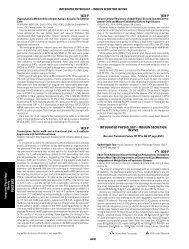Dissecting the Role of Glucocorticoids on Pancreas ... - Diabetes
Dissecting the Role of Glucocorticoids on Pancreas ... - Diabetes
Dissecting the Role of Glucocorticoids on Pancreas ... - Diabetes
You also want an ePaper? Increase the reach of your titles
YUMPU automatically turns print PDFs into web optimized ePapers that Google loves.
GLUCOCORTICOIDS AND PANCREAS DEVELOPMENT<br />
TABLE 1<br />
Comparative analysis <str<strong>on</strong>g>of</str<strong>on</strong>g> body weight, pancreas weight, and fasted glycemia in GR lox/lox ,GR Pdx-Cre , and GR RIP-Cre adult mice<br />
GR lox/lox<br />
almost totally absent in all pancreatic cell types, although<br />
a faint labeling was sometimes detected in islets (Fig. 4B<br />
and E). In GR RIP-Cre mice, <str<strong>on</strong>g>the</str<strong>on</strong>g> GR was specifically deleted<br />
in all differentiated �-cells but remained well expressed in<br />
all o<str<strong>on</strong>g>the</str<strong>on</strong>g>r pancreatic cell types, as expected (Fig. 4C and F).<br />
Female mice were analyzed at adult age (3–4 m<strong>on</strong>ths) and<br />
compared with age-matched c<strong>on</strong>trol females (Table 1). GR<br />
deleti<strong>on</strong> in �-cells did not alter body or pancreatic weight,<br />
but a tendency to decreased fasted glycemia was observed.<br />
GR deleti<strong>on</strong> in Pdx-1–expressing cells did not alter<br />
<str<strong>on</strong>g>the</str<strong>on</strong>g> glycemia or <str<strong>on</strong>g>the</str<strong>on</strong>g> body weight but slightly increased<br />
pancreatic weight (Table 1).<br />
Four to six females at 3–4 m<strong>on</strong>ths <str<strong>on</strong>g>of</str<strong>on</strong>g> age were used for<br />
morphometric analysis <strong>on</strong> immunostained paraffin secti<strong>on</strong>s.<br />
The �-cell fracti<strong>on</strong> increased nearly tw<str<strong>on</strong>g>of</str<strong>on</strong>g>old in<br />
GR Pdx-Cre mice (1.06 � 0.14 vs. 0.65 � 0.13% in c<strong>on</strong>trols,<br />
P � 0.01), in line with an increase in �-cell mass (2.82 �<br />
0.36 vs. 1.50 � 0.52 mg in c<strong>on</strong>trols, P � 0.01) (Fig. 5). In<br />
c<strong>on</strong>trast, �-cell fracti<strong>on</strong> and mass from GR Pdx-Cre animals<br />
were similar to those <str<strong>on</strong>g>of</str<strong>on</strong>g> c<strong>on</strong>trols (Fig. 5C). Fur<str<strong>on</strong>g>the</str<strong>on</strong>g>r char-<br />
GR Pdx-Cre<br />
GR RIP-Cre<br />
n 5 6 4<br />
Body weight (g) 19.2 � 1.4 21.1 � 0.4 (0.14) 19.0 � 0.4 (0.90)<br />
<strong>Pancreas</strong> weight (mg) 225 � 21 277 � 10 (0.05) 217 � 10 (0.80)<br />
<strong>Pancreas</strong> weight (mg/g body wt) 11.7 � 0.4 13.1 � 0.5 (0.04) 11.4 � 0.7 (0.80)<br />
Fasted glycemia (mg/dl) 79 � 3 76� 3 (0.31) 68 � 4 (0.06)<br />
Data are means � SE or means � SE (P). Statistical differences between each mutant group and <str<strong>on</strong>g>the</str<strong>on</strong>g> c<strong>on</strong>trol mice were assessed using <str<strong>on</strong>g>the</str<strong>on</strong>g><br />
Mann-Whitney n<strong>on</strong>parametric test.<br />
acterizati<strong>on</strong> showed that <str<strong>on</strong>g>the</str<strong>on</strong>g> increased �-cell mass arose<br />
from increased islet numbers, mainly small and large islets<br />
(Fig. 6), and increased area <str<strong>on</strong>g>of</str<strong>on</strong>g> <str<strong>on</strong>g>the</str<strong>on</strong>g> large islets (giant islets<br />
�300 �m equivalent diameter were <str<strong>on</strong>g>of</str<strong>on</strong>g>ten observed) (Fig.<br />
5). Individual �-cell area was unchanged in GR Pdx-Cre mice<br />
(188 � 4 vs. 177 � 9 �m 2 in c<strong>on</strong>trols, P � 0.27), indicating<br />
that <str<strong>on</strong>g>the</str<strong>on</strong>g> �-cells were not hypertrophied. The increased<br />
�-cell fracti<strong>on</strong> in GR Pdx-Cre mice was already present in<br />
ne<strong>on</strong>ates at 2.5 days <str<strong>on</strong>g>of</str<strong>on</strong>g> age (3.73 � 0.19 vs. 3.08 � 0.05% in<br />
c<strong>on</strong>trols, n � 4 in each group, P � 0.05). A mutati<strong>on</strong><br />
restricted to �-cells did not have any major c<strong>on</strong>sequences<br />
<strong>on</strong> pancreas morphology, and GR RIP-Cre mice were similar<br />
to <str<strong>on</strong>g>the</str<strong>on</strong>g> c<strong>on</strong>trol group for all parameters analyzed (Figs. 5<br />
and 6), suggesting that glucocorticoids do not play a major<br />
role in differentiated �-cells.<br />
DISCUSSION<br />
In a previous study, we had shown that decreased �-cell<br />
mass was observed under c<strong>on</strong>diti<strong>on</strong>s <str<strong>on</strong>g>of</str<strong>on</strong>g> fetal overexposure<br />
FIG. 5. Increased �-cell mass in GR Pdx-Cre<br />
mice. A:GR Pdx-Cre mice have giant islets.<br />
B: �-Cell fracti<strong>on</strong> and �-cell mass are<br />
increased in GR Pdx-Cre adult female<br />
mice, whereas GR RIP-Cre mice are undistinguishable<br />
from c<strong>on</strong>trol mice. C:<br />
�-Cell fracti<strong>on</strong> and mass are unaffected<br />
in both mutants compared with <str<strong>on</strong>g>the</str<strong>on</strong>g> c<strong>on</strong>trols.<br />
Values are means � SE; *P < 0.05,<br />
**P < 0.01 compared with <str<strong>on</strong>g>the</str<strong>on</strong>g> c<strong>on</strong>trol<br />
group.<br />
2326 DIABETES, VOL. 53, SEPTEMBER 2004
















